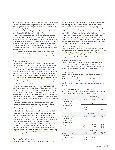
ar2008 35 / 46
10秒後にBOOKのページに移動します
subsidiaries, whose fiscal year ends at the end of March have adopted new accounting standards, “Accounting Standards for Lease Transactions” (Accounting Standards Board of Japan Statement No.13, June 17, 1993, Revised March 30, 2007) and “Guidance on Accounting Standard for Lease Transactions,” (Accounting Standards Board of Japan Guidance No.16, January 18, 1994, Revised March 30, 2007). Under the existing accounting standard, finance leases that stipulate the transfer of ownership of the leased assets to the lessee are to be capitalized, however, other finance leases are permitted to be accounted for as operating lease transactions if certain “as if capitalized” information is disclosed in the note to the lessee’s financial statements. The revised accounting standard requires that all finance lease transactions shall be capitalized recognizing lease assets and corresponding lease obligations in the balance sheet. The depreciation of leased assets shall be calculated based on the assumption that the useful life equals the lease term and the residual value is zero. The adoption of new standard had no material impact on the consolidated financial statements. (k) Retirement benefits Accrued retirement benefits for employees have been provided mainly at an amount calculated based on the retirement benefit obligation and the fair value of the pension plan assets as of the balance sheet date, as adjusted for the unrecognized net retirement benefit obligation at transition and unrecognized actuarial gain or loss. The retirement benefit obligation is attributed to each period by the straight-line method over the estimated years of service of the eligible employees. When pension plan assets are less than retirement benefit obligation as adjusted for the unrecognized actuarial gain or loss, the amount is booked as accrued retirement benefits and when pension plan assets are more than retirement benefit obligation as adjusted for the unrecognized actuarial gain or loss, the amount is booked as prepaid pension cost. Actuarial gain or loss of the Company is amortized in the year following the year in which the gain or loss is recognized by the straight-line method over the average remaining years of service of the eligible employees (13 to 15 years). Actuarial gain and loss of two consolidated subsidiaries are amortized by the straight-line method over a period (5 years and 10 years, respectively) which is shorter than the average remaining years of service of the eligible employees. In addition, directors and corporate auditors of the Company and certain consolidated subsidiaries are customarily entitled to lump-sum payments under the unfunded retirement benefits plans. The provision for retirement benefits for these officers has been made at estimated amounts. On April 1, 2004, the Company changed its rules for tax-qualified pension plans and lump-sum payment plans. As a result, unrecognized prior year service cost to reduce the retirement benefit obligation was incurred. The unrecognized prior year service cost is being amortized by the straight-line method over a period (14 years) which is shorter than the average remaining years of service of the eligible employees. On April 1, 2005, one consolidated subsidiary changed its rules for tax-qualified pension plans and lump-sum payment plans. As a result, unrecognized prior year service cost to reduce the retirement benefit obligation was incurred. The unrecognized prior year service cost is being amortized by the straight-line method over a period (5 years) which is shorter than the average remaining years of service of the eligible employees. (l) Derivative financial instruments The Company has entered into various contracts of derivative financial instruments in order to manage certain risks arising from adverse fluctuations in foreign currency exchange rates and interest rates. Derivative financial instruments are carried at fair value with any changes in unrealized gain or loss charged or credited to income, unless when those which meet certain hedging criteria for special accounting treatment under which any differences paid or received on the interest rate swaps are recognized as adjustments to interest expense over the life of such swaps, thereby adjusting the effective interest rate on the hedged items, which are the underlying borrowings. Receivables and payables hedged by qualified forward foreign exchange contracts are translated at the rates of the corresponding foreign exchange contracts. (m) Appropriation of retained earnings Under the Commercial Code of Japan, the appropriation of retained earnings with respect to a given financial year is made by resolution of the shareholders at a general meeting to be held subsequent to the close of such financial year. The accounts for that year do not, therefore, reflect such appropriations. See Notes 19 and 20. (n) Provision for products recall One of consolidated subsidiaries of the Company provides an accrual for estimated costs to exchange or repair products subject to recall. As a result, operating income and income before income taxes and minority interests decreased \10 million (U.S.$109 thousand). 3. U.S. Dollar Amounts The translation of yen amounts into U.S. dollar amounts is made at \91.03 = U.S.$1.00, the approximate exchange rate at December 31, 2008, and included solely for convenience. The translation should not be construed as a representation that yen have been, could have been, or could in the future be, converted into U.S. dollars at the above or any other rate. 4. Securities and Investment Securities (a) At December 31, 2008 and 2007, held-to-maturity securities for which market prices were available were summarized as follows: Millions of yen December 31, 2008 Carrying value Market value Unrecognized gain Unrecognized gain: Corporate bonds ................. \ . \ . \. Unrecognized loss: Corporate bonds ................. 103 100 (2) Total ........................................ \103 \100 \(2) Thousands of U.S. dollars December 31, 2008 Carrying value Market value Unrecognized gain Unrecognized gain: Corporate bonds ................. $ . $ . $ . Unrecognized loss: Corporate bonds ................. 1,132 1,100 (31) Total ........................................ $1,132 $1,100 $(31) Millions of yen December 31, 2007 Carrying value Market value Unrecognized gain Unrecognized gain: Corporate bonds ................. \100 \100 \0 Total ........................................ \100 \100 \0 Toagosei Co., Ltd. 33